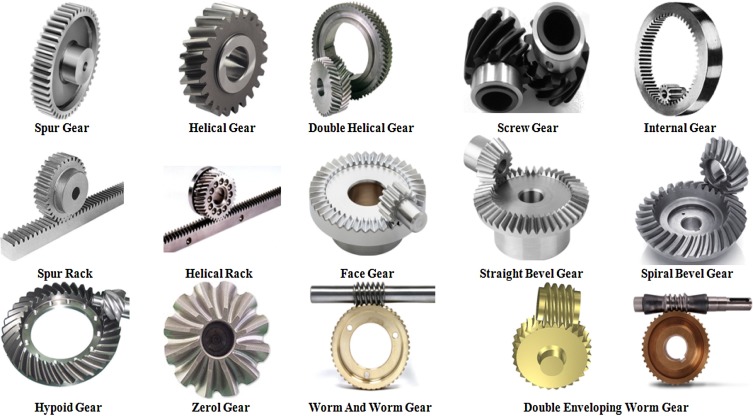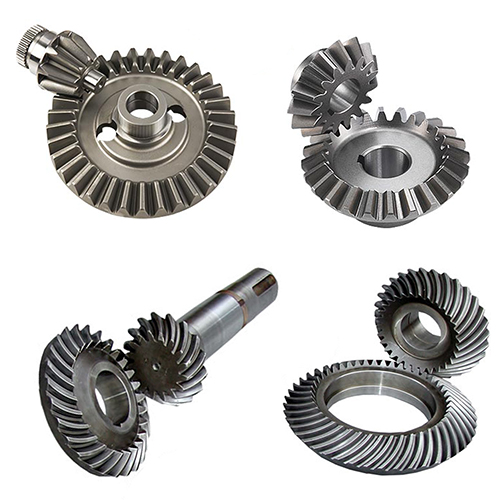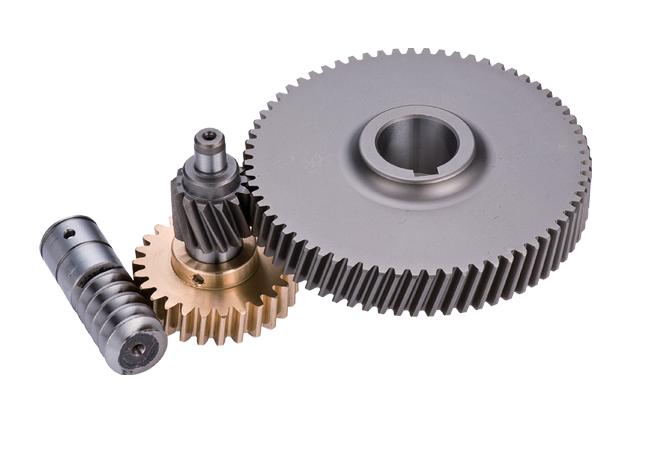Gears are toothed mechanical parts that can be matched with each other. Gear transmission can complete functions such as deceleration, speed increase, and direction change. It is widely used in mechanical transmission and the entire mechanical field.

1.Function and structure of gear
Although gears are designed in different shapes and sizes due to their different functions in the machine, they can always be divided into two parts: ring gear and wheel body. Common cylindrical gears have the following categories (below): disc type gears, sleeve gears, internal gears, shaft gears, sector gears, and racks. Among them, disc gears are the most widely used.
Structure of cylindrical gear
A spur gear can have one or more ring gears. Ordinary single ring gears have good processability; small ring gears of double or triple gears are often affected by shoulders, which limits the use of certain processing methods, and generally only uses gear inserts. If gear accuracy is required, and when tooth shaving or grinding is required, a multi-ring gear is usually made into a combined structure of a single ring gear.
2.Precision requirements for cylindrical gears
The manufacturing accuracy of the gear itself has a great impact on the working performance, load capacity and service life of the entire machine. According to the use conditions of the gear, the following requirements are required for gear transmission:
1.Motion accuracy
It is required that the gear can accurately transfer motion and the transmission ratio is constant, that is, the gear is required to have a rotation angle error within a certain range in one revolution.
2.Work stability
It is required that the gear transfer motion is stable, and shock, vibration and noise are small. This requires that the change in the instantaneous speed ratio be limited when the gear rotates, that is, to limit the angular error in a short period.
3. Contact accuracy
When the gear is transmitting power, in order not to cause excessive contact stress due to uneven load distribution and premature wear of the tooth surface, this requires that the tooth surface contact be uniform when the gear works, and ensure a certain contact area and meet the requirements position.
4.Tooth clearance
When gear transmission is required, there must be a certain gap between the non-working tooth surfaces to store the lubricating oil and compensate for the dimensional changes caused by temperature and elastic deformation and some errors during processing and assembly.
Gear material
The gear should be selected according to the working conditions. The choice of gear material has a direct impact on the processing performance and service life of the gear.
Generally gears are selected from medium carbon steel (such as 45 steel) and low and medium carbon alloy steel, such as 20Cr, 40Cr, 20CrMnTi and so on. ²Critical gears with high requirements can use 38CrMoAlA nitrided steel, non-force transmission gears can also be made of cast iron, cloth bakelite or nylon.
Gear heat treatment
In gear processing, two heat treatment processes are arranged according to different purposes:
1.Rough heat treatment
Pre-heating normalizing or quenching and tempering are arranged before and after the gear blank processing. Its main purpose is to eliminate the residual stress caused by forging and rough machining, improve the machinability of the material and improve the comprehensive mechanical properties.
2.Tooth surface heat treatment
After tooth processing, in order to improve the hardness and wear resistance of the tooth surface, heat treatment processes such as carburizing quenching, high-frequency induction heating quenching, carbonitriding, and nitriding are often performed.
Gear blank
Gears are mainly in the form of bars, forgings and castings. Bar stock is used for gears with small size, simple structure and low strength requirements. When gears require high strength, wear resistance and impact resistance, forgings are often used. Gears with a diameter greater than 400 to 600 mm are often used for casting blanks.
In order to reduce the amount of machining, gear teeth can be directly cast for large-size and low-precision gears; for small-size and complex-shaped gears, new castings such as precision casting, pressure casting, precision forging, powder metallurgy, hot rolling and cold extrusion can be used The process produces tooth blanks with gear teeth to improve labor productivity and save raw materials.
Selection of machining solutions for tooth blanks
For the gear blanks of shaft gears and sleeve gears, the processing process is basically similar to that of ordinary shafts and sleeves. The processing of disk gear blanks is now mainly discussed. The processing technology plan of the gear blank mainly depends on the wheel body structure and production type of the gear.
1.High Volume production of gear blanks
When a large number of medium-sized tooth blanks are processed, the "drill-broaching-turning" process scheme is mostly used.
(1) Drilling or reaming with the outer circle and end face positioning of the blank.
(2) Broaching.
(3) Positioning the outer circle, end face, grooving and chamfering of rough and fine turning on a multi-tool semi-automatic lathe with holes.
This process solution has high production efficiency because it can use assembly lines or automatic lines with high-efficiency machine tools.
2. Low Volume production of gear blanks
In the batch production of tooth blanks, a "turning-broaching-turning" process solution is often used.
(1) Positioning on the outer circle or round shape of the gear blank, finishing the outer circle, end face and inner hole of the car.
(2) Support broaching holes (or spline holes) with end faces.
(3) Position the outer circle and end face with holes.
This solution can be realized by a horizontal lathe or a turret lathe and a broaching machine. It is characterized by stable processing quality and high production efficiency.
When the hole in the gear blank has steps or grooves on the end surface, the multi-tools on the turret lathe can be fully utilized for multi-station processing, and the gear blank can be processed on the turret lathe at one time.

Gear tooth processing method
The tooth shape processing of the gear ring gear is the core of the entire gear processing. There are many procedures for gear processing, these are for the service of tooth profile processing, and the purpose is to finally obtain gears that meet the requirements of accuracy.
According to the processing principle, the tooth shape can be divided into forming method and generating method.
The forming method is a method of cutting the tooth surface with a forming tool that conforms to the shape of the tooth groove of the gear to be cut, such as milling, drawing, and shaping.
The generating method is a method of cutting out the tooth surface according to the meshing relationship between the gear cutter and the workpiece according to the meshing relationship of the gear pair, such as hobbing, inserting, shaving, grinding and honing.
The choice of the tooth profile machining scheme mainly depends on the gear's accuracy grade, structural shape, production type and production conditions. For gears with different accuracy grades, the commonly used tooth profile machining schemes are as follows:
(1) Gears below 8-level accuracy
Quenching and tempering gears can meet the requirements. For hardened gears, we can use: rolling (insertion) teeth-tooth end processing-quenching-correction hole processing scheme. However, the machining accuracy of the tooth profile before quenching should be improved by one level.
(2) 6-7 level precision gear
For hardened gears can be used: coarse hobbing-fine hobbing-tooth end processing-fine shaving-surface hardening-correction datum-tooth.
(3) Gears with level 5 accuracy and above
Generally used: coarse hobbing-fine hobbing-tooth end machining-quenching-correction benchmark-rough grinding-fine grinding. Grinding is currently the highest precision and the smallest surface roughness value in tooth profile processing. The highest precision is 3-4.
1.Gear milling
Gear accuracy level: 9 levels or less
Tooth surface roughness Ra: 6.3 ~ 3.2μm
Scope of application: In the production of one-piece repairs, machining of low-precision external cylindrical gears, racks, bevel gears, worm gears
2.Gear Face Machining
Gear accuracy class: 7
Tooth surface roughness Ra: 1.6 ~ 0.4μm
Scope of application: 7-level internal gears are produced in large quantities. The manufacturing of external gear broaches is complicated, so they are rarely used.
3.Hobbing
Gear accuracy grade: 8 ~ 7 grade
Tooth surface roughness Ra: 3.2 ~ 1.6μm
Scope of application: in various mass production, machining of medium quality outer cylindrical gears and worm gears
4.Gear shaping
Gear accuracy grade: 8 ~ 7 grade
Tooth surface roughness Ra: 1.6 μm
Scope of application: in various mass production, machining of internal and external cylindrical gears, multiple gears and small racks of medium quality
5. Rolling (or inserting) teeth-quenching-honing teeth
Gear accuracy grade: 8 ~ 7 grade
Tooth surface roughness Ra: 0.8 ~ 0.4μm
Scope of application: gears for hardening of tooth surfaces
6. Hobbing—shaving
Gear accuracy grade: 7 ~ 6 grade
Tooth surface roughness Ra: 0.8 ~ 0.4μm
Scope of application: mainly used for mass production
7. Hobbing-shaving-quenching-honing
Gear accuracy grade: 7 ~ 6 grade
Tooth surface roughness Ra: 0.4 ~ 0.2μm
Scope of application: mainly used for mass production
8. Rolling (insertion) teeth-quenching-grinding teeth
Gear accuracy grade: 6 ~ 3 grade
Tooth surface roughness Ra: 0.4 ~ 0.2μm
Scope of application: For tooth surface processing of high-precision gears, low productivity and high cost
9. Rolling (insertion) teeth-grinding teeth
Gear accuracy grade: 6 ~ 3 grade
Tooth surface roughness Ra: 0.4 ~ 0.2μm
Scope of application: For tooth surface processing of high-precision gears, low productivity and high cost
Tooth end machining
The tooth end of the gear is processed by rounding, chamfering, chamfering and deburring, as shown in the following figure. Rounded and pointed gears are easy to enter into meshing state when shifting gears, reducing impact. Chamfer removes sharp edges and burrs on the ends of the teeth.

Contact: Amanda
Phone: +86 138 2885 2656
Tel: +86 138 2885 2656
Add: 2nd Floor NO.39,Zhen'An West Road,Chang An Town, Factory 2:No. 49, 1st Street, Changtang 3rd Industrial Zone, Dalang Town,Dong Guan,China 523878